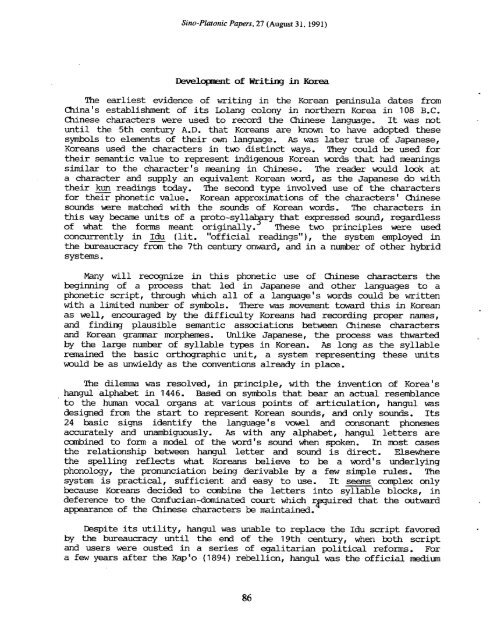Essays on Writing and Language in Honor - Sino-Platonic Papers
Essays on Writing and Language in Honor - Sino-Platonic Papers
Essays on Writing and Language in Honor - Sino-Platonic Papers
Create successful ePaper yourself
Turn your PDF publications into a flip-book with our unique Google optimized e-Paper software.
S<strong>in</strong>o-Ph<strong>on</strong>ic <strong>Papers</strong>, 27 (August 3 1. 199 1)<br />
IXvelqxnent of <strong>Writ<strong>in</strong>g</strong> <strong>in</strong> Korea<br />
The earliest evidence of writ<strong>in</strong>g <strong>in</strong> the Korean pen<strong>in</strong>sula dates from<br />
Ch<strong>in</strong>a's establishment of its Lolang col<strong>on</strong>y <strong>in</strong> northern Korea <strong>in</strong> 108 B.C.<br />
Ch<strong>in</strong>ese characters were used to record the Ch<strong>in</strong>ese language. It was not<br />
until the 5th century A.D. that Koreans are known to have adopted these<br />
symbols to elements of their own language. As was later true of Japanese,<br />
Koreans used the characters <strong>in</strong> tm dist<strong>in</strong>ct ways. They could be used for<br />
their semantic value to represent <strong>in</strong>digenous Korean mrds that had mean<strong>in</strong>gs<br />
similar to the character's mean<strong>in</strong>g <strong>in</strong> Ch<strong>in</strong>ese. The reader would look at<br />
a character <strong>and</strong> supply an equivalent Korean word, as the Japanese do with<br />
their -<br />
kun read<strong>in</strong>gs today. The sec<strong>on</strong>d type <strong>in</strong>volved use of the characters<br />
for their ph<strong>on</strong>etic value. Korean approximati<strong>on</strong>s of the characters ' Ch<strong>in</strong>ese<br />
sounds iere matched with the sounds of Korean words. The characters <strong>in</strong><br />
this way became units of a proto-syllabpry that expressed sound, regardless<br />
of what the £oms meant orig<strong>in</strong>ally. These two pr<strong>in</strong>ciples m e used<br />
c<strong>on</strong>currently <strong>in</strong> - Idu (lit. "official read<strong>in</strong>gsf'), the system employed <strong>in</strong><br />
the bureaucracy f m the 7th century <strong>on</strong>ward, <strong>and</strong> <strong>in</strong> a number of other hybrid<br />
systems.<br />
Many will recognize <strong>in</strong> this ph<strong>on</strong>etic use of Ql<strong>in</strong>ese characters the<br />
beg<strong>in</strong>n<strong>in</strong>g of a process that led <strong>in</strong> Japanese <strong>and</strong> other languages to a<br />
ph<strong>on</strong>etic script, through which all of a language's words could be written<br />
with a limited number of symbols, There was movement toward this <strong>in</strong> Korean<br />
as well, encouraged by the difficulty Koreans had record<strong>in</strong>g proper names,<br />
<strong>and</strong> f<strong>in</strong>d<strong>in</strong>g plausible semantic associati<strong>on</strong>s between Ql<strong>in</strong>ese characters<br />
<strong>and</strong> Korean grammar morphemes. Unlike Japanese, the process was thwarted<br />
by the large number of syllable types <strong>in</strong> Korean. As l<strong>on</strong>g as the syllable<br />
rema<strong>in</strong>ed the basic orthographic unit, a system represent<strong>in</strong>g these units<br />
muld be as unwieldy as the c<strong>on</strong>venti<strong>on</strong>s already <strong>in</strong> place.<br />
The dilemma was resolved, <strong>in</strong> pr<strong>in</strong>ciple, with the <strong>in</strong>venti<strong>on</strong> of Korea's<br />
hangul alphabet <strong>in</strong> 1446. Based <strong>on</strong> symbols that bear an actual resemblance<br />
to the human vocal organs at various po<strong>in</strong>ts of articulati<strong>on</strong>, hangul was<br />
designed from the start to represent Korean sounds, <strong>and</strong> <strong>on</strong>ly sounds. Its<br />
24 basic signs identify the language's vowel <strong>and</strong> c<strong>on</strong>s<strong>on</strong>ant ph<strong>on</strong>emes<br />
accurately <strong>and</strong> unambiguously. As with any alphabet, hangul letters are<br />
canb<strong>in</strong>ed to form a model of the word's sound when spoken. In most cases<br />
the relati<strong>on</strong>ship between hangul letter <strong>and</strong> sound is direct. Elsewfiere<br />
the spell<strong>in</strong>g reflects what Koreans believe to be a word's underly<strong>in</strong>g<br />
- -<br />
ph<strong>on</strong>ology, the pr<strong>on</strong>unciati<strong>on</strong> be<strong>in</strong>g derivable by a few simple rules. The<br />
system is practical, sufficient <strong>and</strong> easy to use. It seems complex <strong>on</strong>ly<br />
because Koreans decided to comb<strong>in</strong>e the letters <strong>in</strong>to syllable blocks, <strong>in</strong><br />
deference to the C<strong>on</strong>fucian-dm<strong>in</strong>ated court which rpr& that the oukd<br />
appearance of the Ch<strong>in</strong>ese characters be ma<strong>in</strong>ta<strong>in</strong>ed,<br />
Despite its utility, hangul was unable to replace the Idu script favored<br />
by the bureaucracy until the end of the 19th century, when both script<br />
<strong>and</strong> users were ousted <strong>in</strong> a series of egalitarian political reforms. For<br />
a few years after the Kap'o (1894) rebelli<strong>on</strong>, hangul was the official medium

















